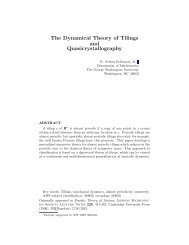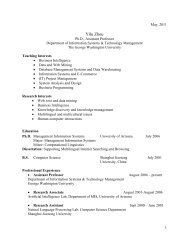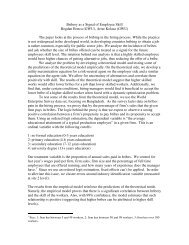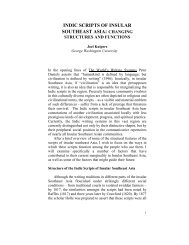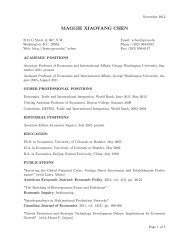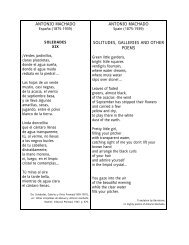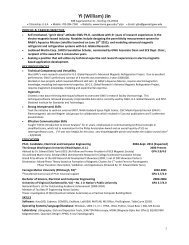Syllabus - gwu.edu - George Washington University
Syllabus - gwu.edu - George Washington University
Syllabus - gwu.edu - George Washington University
Create successful ePaper yourself
Turn your PDF publications into a flip-book with our unique Google optimized e-Paper software.
Prof. Downes IAFF 3180.80/PSC 2990.80 <strong>Syllabus</strong> Fall 2012<br />
COURSE SCHEDULE<br />
Part I. Introduction and Definitions<br />
1. Course Introduction August 28<br />
� Lotta Themnér and Peter Wallensteen, “Armed Conflicts, 1946-2011,” Journal of Peace Research<br />
49, no. 4 (July 2012): 565-575.<br />
2. No Class: American Political Science Association Annual Meeting August 30<br />
� Get a head start on the reading for next week.<br />
3. Definitions, Part I September 4<br />
� Nicholas Sambanis, “What Is Civil War? Conceptual and Empirical Complexities of an<br />
Operational Definition,” Journal of Conflict Resolution 48, no. 6 (December 2004): 814-858 (read<br />
814-831 and 853-857; skim the remainder).<br />
� Stathis N. Kalyvas and Laia Balcells, “International System and Technologies of Rebellion: How<br />
the End of the Cold War Shaped Internal Conflict,” American Political Science Review 104, no. 3<br />
(August 2010): 415-429.<br />
� Stathis N. Kalyvas, “‘New’ and ‘Old’ Civil Wars: A Valid Distinction?” World Politics 54, no. 1<br />
(October 2001): 99-118.<br />
Discussion Questions:<br />
� What kinds of conflicts are included and excluded by mainstream definitions of civil war? Are<br />
these inclusions/exclusions justified? Why?<br />
� What are the different ways that scholars categorize civil wars? What are the key axes along which<br />
these conflicts vary?<br />
� Has the nature of civil war changed over time?<br />
4. Definitions, Part II September 6<br />
� Che Guevara, Guerrilla Warfare (New York: Monthly Review Press, 1961), 7-37 (e-res).<br />
� John A. Nagl, Learning to Eat Soup with a Knife: Counterinsurgency Lessons from Malaya and<br />
Vietnam (Chicago: <strong>University</strong> of Chicago Press, 2002), 15-33 (e-res).<br />
� Kalyvas, Logic of Violence in Civil War, 16-31.<br />
� Bruce Hoffman, Inside Terrorism (New York: Columbia <strong>University</strong> Press, 1998), 13-44 (e-res).<br />
Discussion Questions:<br />
� What distinguishes guerrilla warfare/insurgency from conventional war?<br />
� What is terrorism?<br />
� Is terrorism limited to non-state actors, or can states be terrorists too?<br />
Part II. Causes of Civil War<br />
5. Psychology: Relative Deprivation and Group Comparison September 11<br />
� Ted Robert Gurr, “Psychological Factors in Civil Violence,” World Politics 20, no. 2 (January<br />
1968): 245-278.<br />
� Donald L. Horowitz, Ethnic Groups in Conflict (Berkeley: <strong>University</strong> of California Press, 1985),<br />
141-184 (e-res).<br />
� Roger Petersen, Understanding Ethnic Violence: Fear, Hatred, and Resentment in Twentieth-<br />
Century Eastern Europe (Cambridge: Cambridge <strong>University</strong> Press, 2002), 17-61 (e-res).<br />
6




